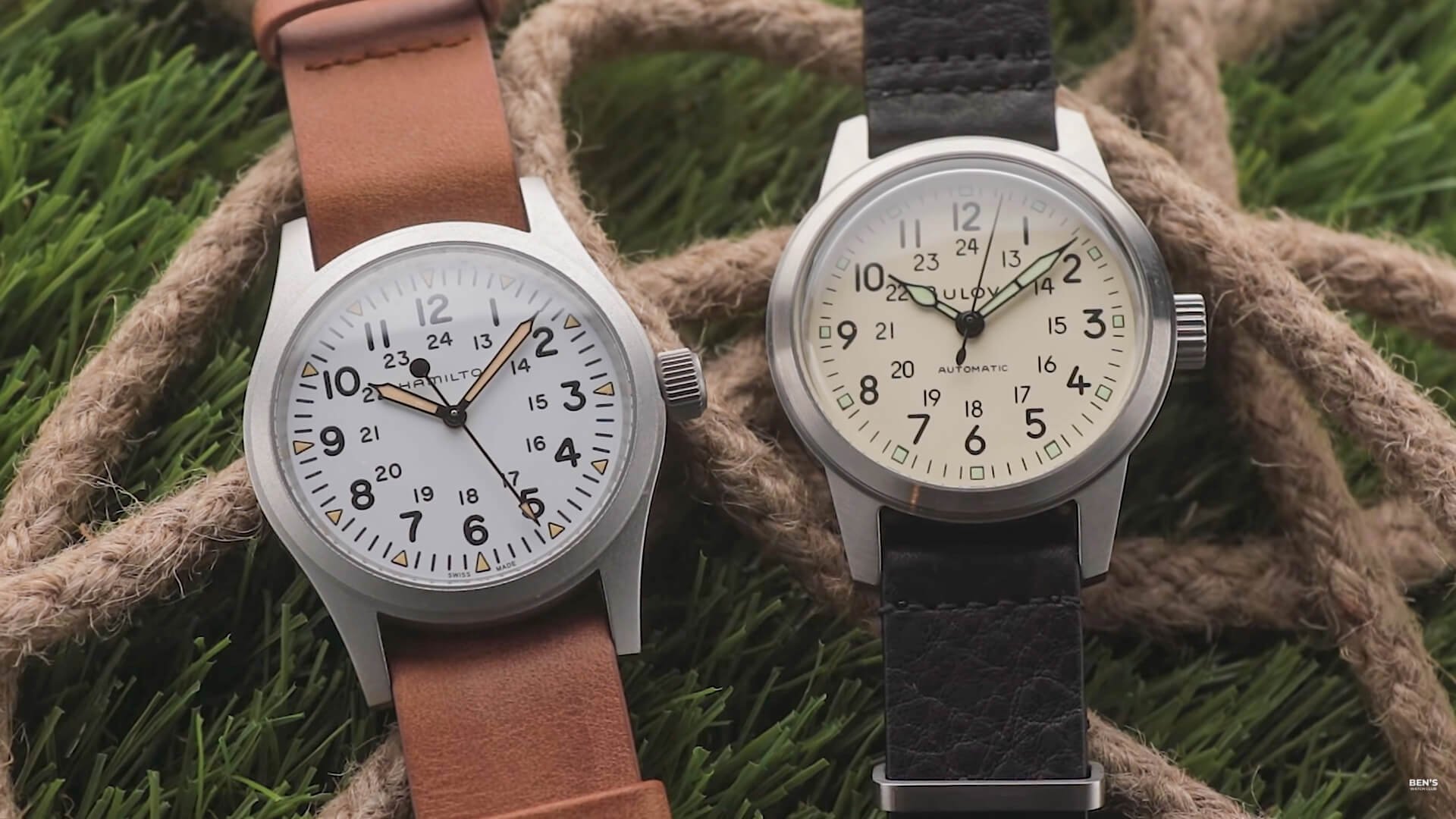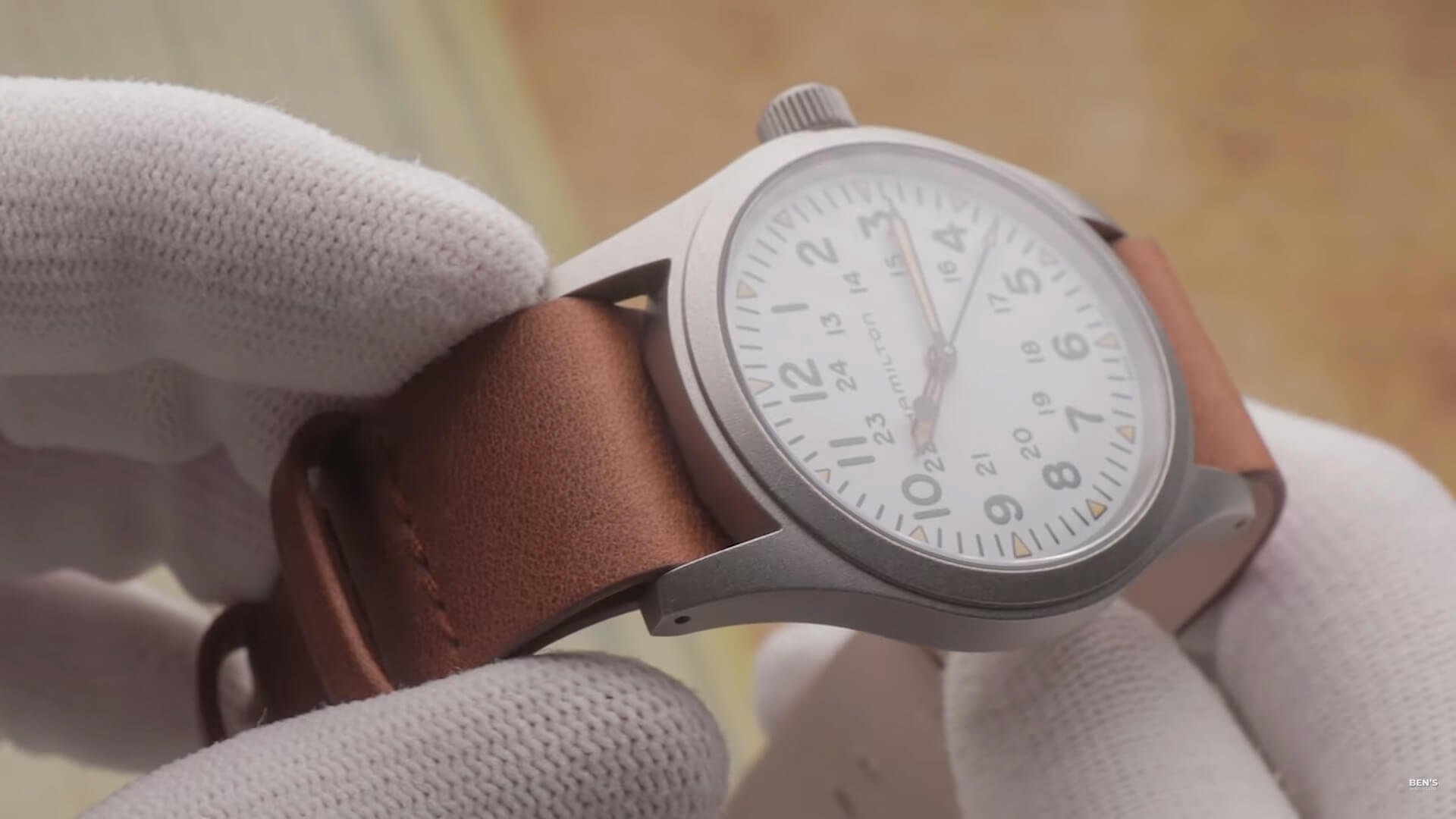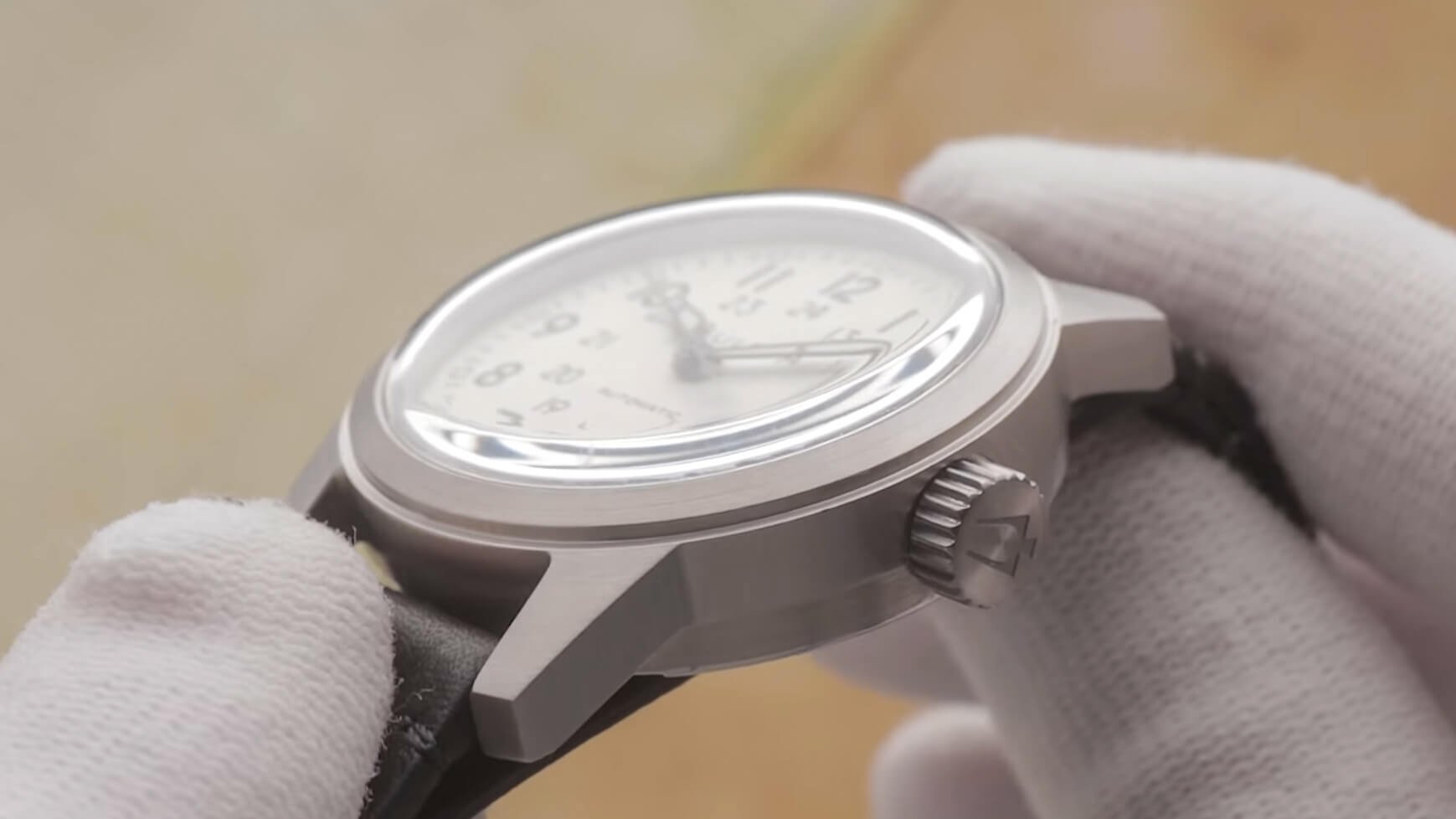Bulova Hack vs Hamilton Khaki - The Best 38mm Field Watch To Buy?
(This page features affiliate links, for more information click here.)
How does this sound?
A 38mm American branded field watch with retro aesthetics and a mechanical movement. Hmm, not bad eh?
Well, what about this?
A 38mm American branded field watch with retro aesthetics and a mechanical movement. No, I don't have horological Tourette's; these are two different watches.
Rival brands with very similar offerings both for under $500? This calls for a Ben's Watch Club duel!
Thanks to Jomashop for sending in both watches for this comparison. As always, they haven't paid me any money for or demanded any creative control over this post. You'll find both options affiliate linked throughout this article.
Price
The Khaki Field Hand Wind is between $330-$400 on Jomashop (depending on color and strap), while the Bulova Hack is priced at $199 and $220 for the two variants at the time of writing. These prices may change due to availability and, more ominously, inflation.
Brand and Packaging
Although originally American, these brands have since headed overseas for their wristwatch production. Currently, all Hamilton watches are made in Switzerland, hence the Swiss-made label visible at the bottom center. Meanwhile, the Bulovas origins are a little less clear. There are no such markings on the dial or box, so we're left guessing. Bulova was bought by Citizen in 2008, so the watch may have been made in Japan, with any origin declaration being omitted to preserve the American theming. Nevertheless, I'd hazard a guess that China is the more likely birthplace, as is the standard among most $200 watches.
As expected, the Hamilton comes in a more grandiose box, with a faux wooden outer and leatherette lining, while the Bulova was delivered in a more standardized container with a grey felt lining. For their respective price points, both are equally suitable. However, I'm docking them both a point for not coming in more practical pouches, as we've seen offered by other affordable microbrands. I feel that most of these boxes will just end up in an attic or, worse, a landfill.
Dimensions
While both 38mm across, the two are more different in shape than you probably think. The Hamilton is sleeker, at a mere 9.5mm thickness, including the domed crystal.
Meanwhile, the Bulova sits stoutly at 13.5mm, incorporating a notably higher crystal and thicker construction, which is boosted to a chunky 15mm with the stock leather strap. While the Hamilton's strap boosts it to 12.5mm, it still lies flusher to the wrist. The Hamilton, in particular, wears slightly larger than I anticipated after having read the spec sheet. The lug to lug length of both models isn't the shortest and you'll notice the Hamilton has a large gap between the case and the spring bars, which feels like an open door for a slip-through strap in particular.
Case Construction
Both options are constructed of industry-standard 316L stainless steel, but each opts for a different type of matte finish. The Hamilton has a blasted look throughout, while the Bulova has a variety of vertically and horizontally brushed surfaces across its stepped case shape.
The latter is more angular, with steep lugs to combat the taller stature, whereas the Hamilton has a more traditional swooping side profile with some slight curvature. I think the design of the Hamilton is cleaner, and while it's tricky to compare different styles of finishing, if I had to side with either, it would be the Hamilton; despite being a close contest. The Khaki also has lug holes for easier strap changes.
Crown & Water Resistance
Neither watch features a screw-down crown or strong water performance, for that matter. I like how tight the Bulova crown sits, unlike its more bulbous contemporary on the Hamilton, which does look a bit like it's permanently unseated. The increased surface area does allow for marginally easier winding, though a couple of millimeters shaved off wouldn't have gone amiss, as it currently looks a little oversized.
Despite both pieces being secured with screw-backs, the Hamilton only offers 5bar water resistance, while the Bulova falls short with a measly 3bar splash resistance rating. Given the chunky build, the latter score was shocking, as it looks easily capable of 10bar. There's always contention around water resistance, as some brands are known to deliberately play it safe to prevent a portion of returns. Nevertheless, prospective buyers would benefit from the added peace of mind assured by a higher rating.
No screw-down crown on the Hamilton does make sense given its manual wind nature, though I've still seen many super-budget watches offering higher designations, which is bizarre. Perhaps that's something to do with the movement type?
Crystal
While both crystals are domed, they each take very different approaches. As expected, the Hamilton features a near-scratchproof sapphire crystal, which is generally considered the optimal material of choice. The arc here is very subtle and low, with tremendous clarity and minimal distortion, even at the steepest of angles.
Alternatively, the Hack has a more aggressive dome that steeply projects from the bezel at the circumference, which creates more vintage-style warping. The downside here is that this is only mineral glass. It's supposedly more challenging to make this crystal shape with sapphire, so perhaps that wasn't within their target budget for this watch.
But, this is still a $200 watch, so even a lesser-domed sapphire alternative would be more desirable for me, given that this is a field watch and not any sort of dress option. That would improve scratch resistance and simultaneously reduce the overall thickness of this rather deep Bulova.
Design
As neither of these pieces are spec juggernauts, they rely on their appearance to pull them through.
You see, this is what lets down many budget field watch offerings. They may have monstrous specs and seem incredible value on paper, but they're let down by either ill-conceived or straight-up stolen designs that don't look particularly good in person.
Luckily, the same can't be said for this pair, as I think they're both impressive. Of course, these brands each have long, illustrious histories that involve ties to the US military. The mid-century combat aesthetic is well and truly on display here, with the Hack and Khaki acting as reissues of original designs produced during that era.
The Bulova Hack is perhaps the most committed to the vintage illusion, with an off-white color that looks straight out of the 40s or 50s. Green-tinged rectangles sit outside each Arabic numeral, with a dated version of the Bulova logo reintroduced above the central stem, while the modern tuning fork logo has been relegated to the case rear.
While comparable, the Khaki Field has a fresher look that includes a bright white dial and more contemporary typefaces such as the current Hamilton logo. There is still an attempt to ride the vintage wave, primarily via the faux patina applied to the hands and indices. While not as convincing as that on the Hack, I personally prefer the orange tone used here and think it results in a more versatile final look that goes better with modern attire.
The same could be said for the handsets, which are the main differentiating factor at a glance. The cathedral-style pointers present on the Bulova are again very period-accurate but perhaps haven't aged as well as the hybrid baton-syringe hands implemented on the Hamilton, which remain sleek to this day. I prefer the second hand on the latter too, which has a painted triangular tip that elegantly matches the inward-facing markers.
The text on both is inked throughout and contrasts starkly with the dials for maximum legibility. To the naked eye, the inking on the Hamilton is a touch more precise, and the lacquered finish does a better job of matching that present on the hands. Nevertheless, the Hack is still elegant for the price tag and looks better than many budget offerings I've reviewed in the past.
Tasteful is probably the best word to describe the designs of each. I'd happily be caught wearing both of these watches. They're awesome.
Movement
Despite being based on older watches, these reissues do boast modern movements. Interestingly, as the name implies, the original Hack watch provided to the US military in the 40s was one of the earliest to boast hacking functionality, allowing the user to set the time more accurately by stopping the second hand. This was useful during World War 2 and continues to be a useful tool today for those after precise mechanical timekeeping. The automatic Miyota 8S20-43A, provided by parent company Citizen, also accommodates hand-winding and possesses a self-winding rotor for improved quality of life. This is essentially an 821 series movement that is more easily adapted for skeletonized use, and the rotor is noisy when the watch is rotated. I'm unsure why this movement has been used on a fully sealed watch, but it's reasonable for the cost.
Bulova Miyota 8S20-43A Movement
Hamilton H-50 Movement
How come the Hamilton is so much slimmer then? Well, the secret lies under the hood. This one is powered by the hand-wound Hamilton H-50 movement based on the previously used ETA 2801-2. The beat rate has been reduced, though the power reserve has been upgraded to 80 hours, double the Bulova. This mechanical powerhouse is wafer-thin, partly due to the absence of a winding rotor, allowing it to be squeezed into the tiniest of spaces. A side effect of this is that the watch cannot wind itself when on-wrist, requiring you to wind the watch when the power reserve begins depleting.
That being said, 80 hours is a very generous amount of time, making it an attractive proposition for those like me who alternate between different watches. You could forget to wind this one for over 3 days and still be fine. My sieve-like memory has already put that to the test!
There is an automatic Hamilton Khaki Field for around $100 more at the time of posting, though it does offer a somewhat dressier look that doesn't make it as well-suited for this comparison.
Lume
The brightness and dispersion of lume is similar on each of these. The Khaki maintains its level for longer, though the Hack probably edges it in price to performance as it's not far off. Neither are exceptionally bright compared to some microbrands I've tested in the same price bracket, but they are visible for the most part.
Straps
The Bulova absolutely trumps the Hamilton in the strap department. The latter is awful for a $350 watch, with a cheap, plasticky feel resembling something from a $20 AliExpress knock-off. I'd certainly rather brands cut costs on straps rather than the watches themselves, but this takes it to the extreme. It's inadequate for a watch costing this much money.
Hamilton Watch Strap
Bulova Watch Strap
I'll link a 20mm replacement here to save you the pain. You can opt for that or spend out for the bracelet version instead.
Surprisingly, the Hack is kitted out with something from the opposite end of the spectrum, despite costing less. This is a peculiar type of NATO-style strap that is fixed to the lugs and only passes under the case a single time, thus halving additional bulkiness. The black one fitted here has a finely grained texture with nicely machined keepers and a pleasing supple feel that blows its competitor out of the water.
Obviously, straps are far from the most crucial aspect of a wristwatch. Still, it's worth highlighting that this Bulova-branded strap is very impressive and could prevent you from needing an upgrade for the foreseeable future.
Final Thoughts
Having tried both of these over the last few weeks, I have to say the Bulova has grown on me. I already knew I'd like the look of the Khaki from the stock images, but in person, that lug to lug makes it wear a fair amount larger than I had envisaged – to the point where it's probably a little big for my 15.5cm wrist. I'm also not keen on that gap between the strap and case. Either way, any worries about this looking like a cheap Timex Weekender were quickly alleviated upon unboxing, as this is undeniably gorgeous.
Most likely due to the angled lug tips and narrower 18mm lug width, I think the Bulova suits my skinny arm much better despite the significantly thicker case. I'm not keen on how the low-sitting logo is often blocked by the hands, but aside from that, I think it's a very cool little watch. I believe the Hamilton is of higher quality and is probably the better choice for average-sized wrists, but the Bulova is certainly a viable alternative if you don't want to spend that much or are too slim to pull it off.
For more field watch options check out this post next, where I compare 3 Seikos.
























